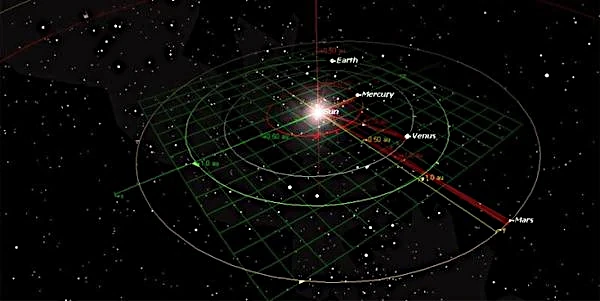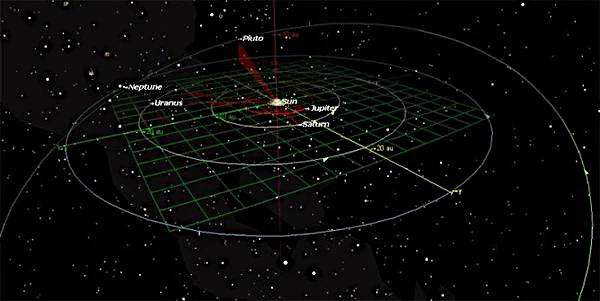
The planetary orbits of the Solar System result from a balance between gravity and the tangential velocity of each planet. According to the universal law of gravitation formulated by Isaac Newton (1643-1727), two bodies with masses \(m_1\) and \(m_2\) attract each other with a force: \[ F = G \frac{m_1 m_2}{r^2} \] where \(G = 6{,}674 \times 10^{-11}\ \text{N·m}^2·\text{kg}^{-2}\) is the gravitational constant. This interaction generates trajectories that, according to the laws of Johannes Kepler (1571-1630), are elliptical with the Sun at one focus.
The stability of the Solar System has long been debated. Pierre-Simon Laplace (1749-1827) demonstrated, within the framework of perturbation theory, that planetary resonances could compensate each other over long timescales, ensuring secular stability. However, orbital resonance effects, such as those between Jupiter and Saturn (5:2 resonance), induce slow changes called secular variations.
The introduction of chaos theory in the 20th century, notably by Henri Poincaré (1854-1912), transformed the classical view of celestial mechanics. He showed that even a system obeying perfectly deterministic laws could display unpredictable long-term behavior. In the Solar System, the equations of motion become nonlinear and sensitive to initial conditions. Multiple gravitational interactions can lead to phase shifts or instabilities. Thus, while the Solar System appears stable over millions of years, modern numerical simulations show that some orbits could diverge after several hundred million years.
Orbital and spin-orbit resonances partially maintain the coherence of planetary motion. For example, the 3:2 resonance between Mercury and the Sun stabilizes its rotation, while the 1:2:4 resonance among Io, Europa, and Ganymede (moons of Jupiter) illustrates the dynamic equilibrium of a multi-body system.
These integer ratios between orbital periods allow gravitational perturbations to be redistributed regularly, limiting short-term chaos.
| Bodies involved | Resonance type | Orbital ratio | Dynamical effect |
|---|---|---|---|
| Mercury – Sun | Spin–orbit | 3:2 | Stabilizes Mercury's rotation by minimizing tidal torques; balances between full locking and free rotation, reducing extreme thermal gradients between hemispheres. |
| Moon – Earth | Spin–orbit | 1:1 | Synchronous rotation: the Moon always shows the same face; tidal dissipation gradually slows Earth's rotation and increases the Moon’s orbital distance (~3.8 cm/year). |
| Io – Europa – Ganymede | Multiple orbital | 1:2:4 | Maintains Io’s orbital eccentricity, inducing intense tidal heating (volcanic activity); stabilizes the inner Jovian system and regulates secondary Laplace resonances. |
| Neptune – Pluto | Orbital | 3:2 | Prevents close encounters: Pluto reaches perihelion when Neptune is 90° out of phase; long-term stabilization despite geometric orbit crossing. |
| Jupiter – Saturn | Secular orbital | 5:2 | Causes slow modulation of planetary eccentricities (long-period resonance); influences overall Solar System stability and secular cycles (~100,000 years, Laskar). |
| Enceladus – Dione | Orbital | 2:1 | Induces periodic pumping of Enceladus’ eccentricity, sustaining tidal dissipation; feeds its subsurface ocean and observed cryovolcanism at the south pole. |
| Mimas – Tethys | Orbital | 2:1 | Stabilizes orbital inclinations and gravitationally influences gaps in Saturn’s rings; creates resonant structures (density waves and gaps). |
| Asteroids – Jupiter (Kirkwood gaps) | Orbital | 3:1, 5:2, 2:1 | Strong resonances with Jupiter increase asteroid eccentricities, causing ejection from the main belt; formation of empty zones (Kirkwood gaps) and chaotic trajectories. |
| ν6 resonance (Saturn) | Secular | Variable | Synchronization between asteroid perihelion precession and Saturn’s; gradual eccentricity growth up to crossing Mars or Earth, causing ejection inward and production of potential meteoroids. |
| ν5 resonance (Jupiter) | Secular | Variable | Coupling between small body perihelion precession and Jupiter’s; modifies eccentricity and inclination cycles, structures secular planetary dynamics, and affects trans-Neptunian resonances. |
Note:
Meteoroid: small solid body moving through interplanetary space before interacting with an atmosphere.
Meteorite: solid remnant of a meteoroid that reaches the surface of a celestial body (Earth, Moon, Mars…).
Meteor: luminous phenomenon produced when a meteoroid enters an atmosphere (via friction and ionization).
The inner orbits (Mercury, Venus, Earth, Mars) are fast, compact, and densely populated, while the outer orbits (Jupiter, Saturn, Uranus, Neptune) are wide, massive, and governed by strong gravitational resonances, illustrating the hierarchy and harmony of the Solar System.

Despite their apparent regularity, planetary orbits slowly evolve under the combined influence of mutual perturbations, tidal forces, and energy dissipation. The Solar System’s harmony lies in this dynamic balance between order and chaos.
Orbital harmony is not static. Tidal forces, solar mass loss, and minor gravitational interactions slowly modify orbital parameters. Eccentricity \(e\), inclination \(i\), and longitude of perihelion \(\omega\) vary over cycles of tens of thousands of years. These variations, described by the cycles of Milutin Milankovitch (1879-1958), directly influence Earth’s climate.
| Planet | Semi-major axis (AU) | Eccentricity | Inclination (°) | Orbital period (years) |
|---|---|---|---|---|
| Mercury | 0.387 | 0.2056 | 7.00 | 0.24 |
| Venus | 0.723 | 0.0068 | 3.39 | 0.62 |
| Earth | 1.000 | 0.0167 | 0.00 | 1.00 |
| Mars | 1.524 | 0.0934 | 1.85 | 1.88 |
| Jupiter | 5.203 | 0.0484 | 1.31 | 11.86 |
| Saturn | 9.537 | 0.0542 | 2.49 | 29.46 |
| Uranus | 19.191 | 0.0472 | 0.77 | 84.01 |
| Neptune | 30.068 | 0.0086 | 1.77 | 164.8 |
Source: NASA – Jet Propulsion Laboratory (Solar System Dynamics) and Laskar, J. (1999) – The Limits of Stability in the Solar System.
During the formation of the Solar System, the system contained many more planets, planetary embryos, and planetesimals. This initial period, often called chaotic, was characterized by frequent collisions, intense energy exchanges, and multiple gravitational perturbations. Numerical simulations indicate that some planets or planetary embryos were ejected into interstellar space or absorbed by more massive bodies. This process of dynamical relaxation helped clear the system, leaving only orbits compatible with the gravitational hierarchy and stabilizing resonances.
Primordial chaos was thus essential for the orbital natural selection of planetary bodies. Traces of these events are still observed today in the asteroid belt, comet populations, and trans-Neptunian objects.
After this initial phase, the remarkable stability of the Solar System over the past ~4.5 billion years results from a subtle balance between gravitational resonances, energy dissipation, and mass hierarchy. Despite the complexity of interactions, the system remains globally quasi-integrable in the Hamiltonian sense: small perturbations have not led to widespread chaos.
The first reason lies in the hierarchical distribution of masses. The Sun/planet ratio (\(M_{\odot}/M_J \approx 10^3\)) grants quasi-stationarity to the center of mass. Planetary dynamics can then be treated as a series of secular motions around mean orbits, following the solutions of Pierre-Simon Laplace (1749–1827) and Joseph-Louis Lagrange (1736–1813).
Stabilizing resonances play a regulatory role. Near-integer period ratios (e.g., 5:2 for Jupiter and Saturn) prevent indefinite amplification of eccentricities and inclinations. These resonances limit orbital energy transfer by confining oscillations within restricted phase zones, analogous to gravitational potential wells.
Recent numerical studies (Jacques Laskar, 1989–2010) show that the inner Solar System exhibits limited deterministic chaos: orbital elements vary unpredictably over long timescales, but total energy and conserved quantities prevent macroscopic divergence. In other words, chaos exists locally but is contained by the system’s global gravitational topology.
Thus, stability over billions of years does not result from the absence of chaos but from a coexistence of regularity and confined instability. This fragile balance, maintained by resonances and mass hierarchy, explains why no major planet has been ejected since the end of the initial chaotic phase.